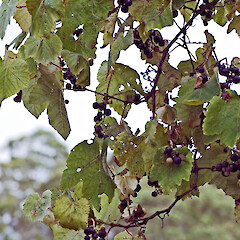Vitis vinifera
Common name
grape
Family
Vitaceae
Flora category
Vascular – Exotic
Structural class
Lianes & Related Trailing Plants - Dicotyledons
NVS code
The National Vegetation Survey (NVS) Databank is a physical archive and electronic databank containing records of over 94,000 vegetation survey plots - including data from over 19,000 permanent plots. NVS maintains a standard set of species code abbreviations that correspond to standard scientific plant names from the Ngä Tipu o Aotearoa - New Zealand Plants database.
VITVIN
Conservation status
Not applicable
Habitat
Around old gardens and dump sites, sometimes along roadsides.
Detailed description
Deciduous woody liane, climbing via tendrils (usually forked). The young shoots and leaves are greyish white or pale brown, mature leaves green above, whitish or pale grey tomentose below, up to 17x18cm, and coarsely toothed. The flowers are green and fragrant, berries 0.7-1.5cm diameter, black and sweet.
Similar taxa
Grapes are very distinctive plants. Only 1 species is recognised as naturalised in New Zealand, but many plants may not be V. vinifera. True V. vinifera has tendrils in every 3rd leaf. V. labrusca has tendrils in every node. Cultivated hybrids have been referred to as V. labruscana have intermittant tendrils.
Flowering
October, November, December
Flower colours
Green
Life cycle
True V. vinifera is very susceptible to philloxera. Reproduces mainly by stem layering (Webb et al., 1988). Fruit is freely produced but most wild spread is not by seed. Many of the cultivated grapes are actually hybrids which may affect spread from seed.
Year naturalised
1870
Origin
Mediterranean
Reason for introduction
Agricultural





